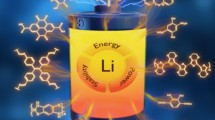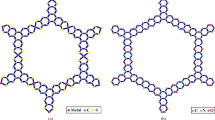Abstract
N,N’-linked bis-1,2,4-trizaoles compounds substituted with different groups such as -NH2, -NO2, -NHNO2, -OH and -CH(NO2)2 were designed and studied by density functional theory (DFT) at B3LYP/6-311+G(2df, 2p) level. The calculated results of heats of detonation, detonation velocities, detonation pressures, bond dissociation energy and impact sensitivity (h50) indicated that -NO2, -NHNO2 and -CH(NO2)2 groups play an important role in elevating the detonation performances of designed compounds, and -NO2 group play an important role in elevating the thermal stability of designed compounds, and the designed compounds with -NO2 and -NHNO2 groups were less sensitivity than that of -CH(NO2)2 group. The calculated detonation performances, thermal stability and impact sensitivity of designed compounds were compared with those of some classical explosives such as 1,3,5-trinitro-1,3,5-triazinane (RDX) and 1,3,5,7-tetranitro-1,3,5,7-tetrazocane (HMX). The computed results show that 3,5,3’-trinitro-4,4’-bis-1,2,4-triazoles (B3) possess higher detonation performances and thermal stability than that of RDX, but more sensitivity than that of RDX; 3,5,3’,5’-tetradinitromethyl-4,4’-bis-1,2,4-triazoles (E4) possess higher detonation performances than that of RDX, but lower thermal stability and more sensitivity than that of RDX; 3,5,3’,5’-tetranitro-4,4’-bis-1,2,4-triazoles (B4) possess higher detonation performances and thermal stability than that of HMX, but more sensitivity than that of HMX; 3,5,3’,5’-tetranitramine-4,4’-bis-1,2,4-triazoles (C4) possess higher detonation performances than that of HMX, and similar sensitivity to HMX, but lower thermal stability than that of and HMX.




Similar content being viewed by others
References
Alexander AD, Thomas MK (2012) Nitrogen-rich bis-1,2,4-triazoless-A comparative study of structural and energetic properties. Chem Eur J 18:16742–16753
Wang R, Xu H, Guo Y, Sa R, Shreeve JM (2010) Bis[3-(5-nitroimino-1,2,4-triazoles)]-based energetic salts: Synthesis and promising properties of a new family of high-density insensitive materials. J Am Chem Soc 132:11904–11905
Alexander AD, Thomas MK (2013) A study of dinitro-bis-1,2,4-triazoles-1,1’-diol and derivatives: Design of high-performance insensitive energetic materials by the introduction of N-oxides. J Am Chem Soc 135:9931–9938
Bao F, Zhang GZ, Jin SH, Zhang YP, Shu QH, Li LJ (2018) Theoretical study of the heats of formation, detonation properties, and bond dissociation energies of substituted bis-1,2,4-triazoles compounds. J Mol Model 4:85
He P, Mei HZ, Yang JQ, Zhang JG (2019) Design and properties of a new family of bridged bis(nitraminotetrazoles) as promising energetic materials. New J Chem 43:4235–4241
Xiao MH, Jin XH, Zhou JH, Hu BC (2019) Molecular design and selection of 1,2,5-oxadiazole derivatives as high-energy density materials. New J Chem 43:11610–11617
Pan Y, Zhu WH (2017) Theoretical design on a series of novel bicyclic and cage nitramines as high energy density compounds. J Phys Chem A 121:9163–9171
Lide DR (2004) CRC handbook of chemistry and physics (section 5), 84th edn. CRC Press, Boca Raton
Handrick GR (1956) Heats of combustion of organic compounds. End Eng Chem 48:1366–1374
Ornellas DL (1974) The heat and products of detonation in a calorimeter of CNO, HNO, CHNF, CHNO, CHNOF, and CHNOSi explosives. Combust Flame 23:37–46
Lemi T, Taner A (2006) Quantum chemical study on 5-nitro-2,4-dihydro-3H-1,2,4-triazol-3-one (NTO) and some of its constitutional isomers. J Hazard Mater 137:1333–1344
Ghule VD (2012) Computational studies on the triazoles-based high energy materials. Comput Theor Chem 992:92–96
Zhao GZ, Lu M (2013) Comparative theoretical studies of energetic pyrazole-pyridine derivatives. J Mol Model 19:3403–3410
Talawar MB, Sivabalan R, Mukundan T, Muthurajan H, Sikder AK, Gandhe BR, Rao AS (2009) Environmentally compatible next generation green energetic materials (GEMs). J Hazard Mater 161:589–607
Cao Q (2013) Dinitroamino benzene derivatives: A class new potential high energy density compounds. J Mol Model 19:2205–2210
Wu Q, Zhu WH, Xiao HM (2013) Theoretical design of energetic nitrogen-rich derivatives of 1,7-diamino-1,7-dinitrimino-2,4, 6-trinitro-2,4,6-triazaheptane. J Mol Model 19:2945–2954
Author information
Authors and Affiliations
Corresponding authors
Additional information
Publisher’s note
Springer Nature remains neutral with regard to jurisdictional claims in published maps and institutional affiliations.
Electronic supplementary material
ESM 1
(DOCX 305 kb)
Rights and permissions
About this article
Cite this article
Bao, F., Jin, S., Li, Y. et al. Design and properties of N,N’-linked bis-1,2,4-triazoles compounds as promising energetic materials. J Mol Model 26, 130 (2020). https://doi.org/10.1007/s00894-020-04371-y
Received:
Accepted:
Published:
DOI: https://doi.org/10.1007/s00894-020-04371-y




